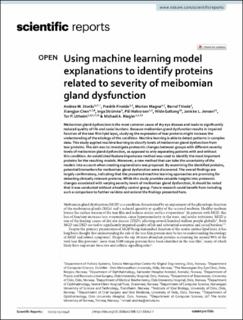| dc.contributor.author | Storås, Andrea | |
| dc.contributor.author | Magnø, Morten Schjerven | |
| dc.contributor.author | Fineide, Fredrik | |
| dc.contributor.author | Thiede, Bernd | |
| dc.contributor.author | Chen, Xiangjun | |
| dc.contributor.author | Strumke, Inga | |
| dc.contributor.author | Halvorsen, Pål | |
| dc.contributor.author | Utheim, Tor Paaske | |
| dc.contributor.author | Riegler, Michael Alexander | |
| dc.date.accessioned | 2024-01-15T09:20:08Z | |
| dc.date.available | 2024-01-15T09:20:08Z | |
| dc.date.created | 2023-12-12T12:14:59Z | |
| dc.date.issued | 2023 | |
| dc.identifier.issn | 2372-9198 | |
| dc.identifier.uri | https://hdl.handle.net/11250/3111438 | |
| dc.description.abstract | Meibomian gland dysfunction is the most common cause of dry eye disease and leads to significantly
reduced quality of life and social burdens. Because meibomian gland dysfunction results in impaired
function of the tear film lipid layer, studying the expression of tear proteins might increase the
understanding of the etiology of the condition. Machine learning is able to detect patterns in complex
data. This study applied machine learning to classify levels of meibomian gland dysfunction from
tear proteins. The aim was to investigate proteomic changes between groups with different severity
levels of meibomian gland dysfunction, as opposed to only separating patients with and without
this condition. An established feature importance method was used to identify the most important
proteins for the resulting models. Moreover, a new method that can take the uncertainty of the
models into account when creating explanations was proposed. By examining the identified proteins,
potential biomarkers for meibomian gland dysfunction were discovered. The overall findings are
largely confirmatory, indicating that the presented machine learning approaches are promising for
detecting clinically relevant proteins. While this study provides valuable insights into proteomic
changes associated with varying severity levels of meibomian gland dysfunction, it should be noted
that it was conducted without a healthy control group. Future research could benefit from including
such a comparison to further validate and extend the findings presented here. | en_US |
| dc.language.iso | eng | en_US |
| dc.rights | Navngivelse 4.0 Internasjonal | * |
| dc.rights.uri | http://creativecommons.org/licenses/by/4.0/deed.no | * |
| dc.title | Identifying Important Proteins in Meibomian Gland Dysfunction with Explainable Artificial Intelligence | en_US |
| dc.type | Peer reviewed | en_US |
| dc.type | Journal article | en_US |
| dc.description.version | publishedVersion | en_US |
| cristin.ispublished | true | |
| cristin.fulltext | original | |
| cristin.qualitycode | 1 | |
| dc.identifier.doi | 10.1109/CBMS58004.2023.00217 | |
| dc.identifier.cristin | 2212319 | |
| dc.source.journal | IEEE International Symposium on Computer-Based Medical Systems | en_US |

